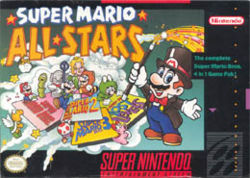Super Mario All-Stars

| |
| Super Mario All-Stars | |
| Developer | Nintendo EAD |
| Publisher | Nintendo |
| System | Super NES, Wii |
| Release Date | SNES JP July 14, 1993 US August 2, 1993 EU December 6, 1993 AU February 1994 Wii JP October 21, 2010 EU December 3, 2010 US December 12, 2010 |
| Rating | ESRB: K-A |
Super Mario All-Stars was a compilation of Super NES remakes of all four of the Super Mario Bros. games from the NES. It also marked the first international release of the Japanese version of Super Mario Bros. 2, under the name Super Mario Bros.: The Lost Levels
Gameplay[edit]
The game included Super Mario Bros., Super Mario Bros. 2: The Lost Levels, Super Mario Bros. 2, and Super Mario Bros. 3. These games were all enhanced to feature the same graphics, which were based on those of Super Mario World. Beyond that and the differences listed below, the games were mostly the same as their original releases.
Differences[edit]
- The maze levels in Super Mario Bros. used a sound effect to indicate whether the right or wrong path was taken.
- The Minus World glitch was removed from Super Mario Bros.
- Luigi was now depicted to be taller than Mario in instances where they were the same height.
- The poison mushrooms now had blue spots instead of black and had a skull instead of the regular mushroom pattern.
- Players were allowed to save their game.
- In Super Mario Bros. 2, players were now allowed to switch characters any time they lose a life.
- The secret mushroom houses from Super Mario Bros. 3 were turned blue instead of the original white.
- The kings from Super Mario Bros. 3 were turned into specific creatures from the Mario games instead of real world animals.
Legacy[edit]
Super Mario All-Stars was notable as one of the first big examples of Nintendo porting and remaking their games on other systems, and it is one of their few notable compilation remakes. It was followed by other remakes over the years, such as Super Mario Bros. Deluxe and the Super Mario Advance games.
Ports and Remakes[edit]
- In December 1994, Super Mario All-Stars + Super Mario World was released. The game was mostly the same, except for the inclusion of Super Mario World. It was bundled with Super NES systems in America and available separately in Europe. This version was no made available in Japan.
- In 2010, Super Mario All-Stars: Limited Edition was released on the Nintendo Wii to commemorate the 25th Anniversary of Super Mario Bros. It' featured the original All-Stars on a Wii disc and came packaged with a history booklet as well as a CD with various Mario tracks.
- In September 2020, Super Mario All-Stars was added to the library of Super NES games that were available to play on the Nintendo Switch for any use with a Nintendo Switch Online account. It was added to celebrate the 35th anniversary of Super Mario Bros..
Sequels[edit]
It received a follow-up in 2020 in the form of Super Mario 3D All-Stars. This game was a compilation of three 3-D Mario adventures (Super Mario 64, Super Mario Sunshine and Super Mario Galaxy).
Trivia[edit]
- Shortly after the release of Super Mario All-Stars, Nintendo Power issued the World 9 Challenge. Anyone who made it to World 9 in The Lost Levels was given a patch that said "Certified Mario Maniac" and "World 9 Challenge".
- In some copies of Super Mario All-Stars, some of the debug code was left over. Pressing Select will let the player cycle through suits. Holding A, B, X, or Y , and pressing Select will toggle Kuribo's Shoe.